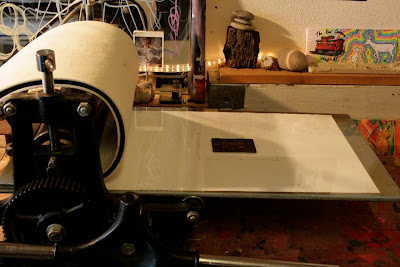 make a template for positioning plate and paper,
make a template for positioning plate and paper, and get the press set up with blankets
and get the press set up with blankets Next, I get my ink out
Next, I get my ink out(we'll have black, blue and brown available)...
 and start spreading it on to the plate -
and start spreading it on to the plate -
The rubber spatula makes it easier to spread ink
in to all the cracks and crevices of the plate.
 Now, I begin to wipe the plate.
Now, I begin to wipe the plate.I start by scraping the top layer of ink from the plate
with a piece of mat board. This removes most of the excess ink.
 Next, using a balled up piece of tarlatan,
Next, using a balled up piece of tarlatan, I wipe the plate. The surface ink gets picked up in the weave of the tartlatan
I wipe the plate. The surface ink gets picked up in the weave of the tartlatan Using my template, I place the plate on to the press bed.
Using my template, I place the plate on to the press bed.
Now, using a bent playing card to keep my inky fingers from
leaving finger maks all over my paper,
I remove the soaked paper and let it drip...
 ...and then I blot the paper dry.
...and then I blot the paper dry.
 After passing through the press,
After passing through the press, you can see the embossing of the plate
on the back side of the paper.
 Peal the the paper back from the plate
Peal the the paper back from the plateand, voila!
A Collagraph Print
 These inks take a good deal of time to dry
These inks take a good deal of time to dryso I like to give the print a week or so before
handling or framing. After that I've
an archival print that should last well beyond
my great grandchildren's lifetime.








 Self Portrait Cut Out
Self Portrait Cut Out Next I cut out the plate...
Next I cut out the plate...










